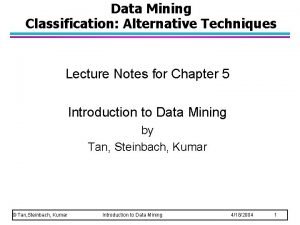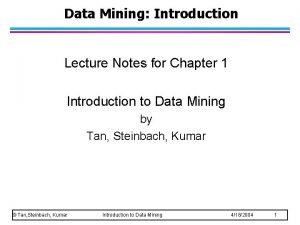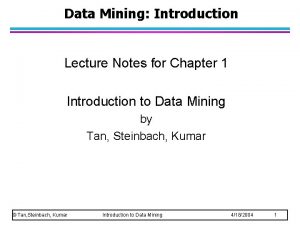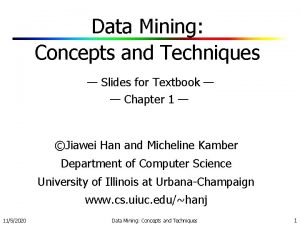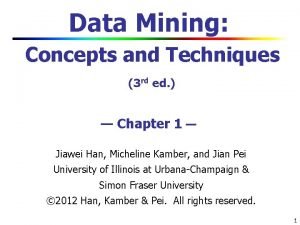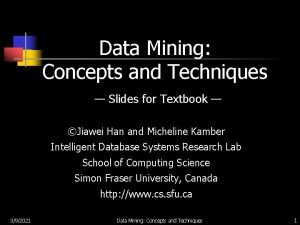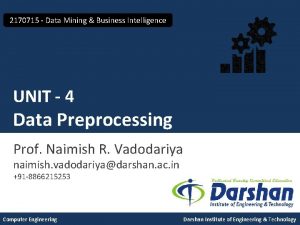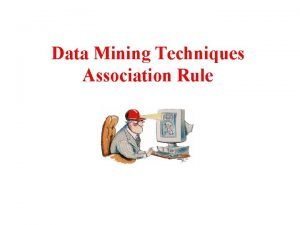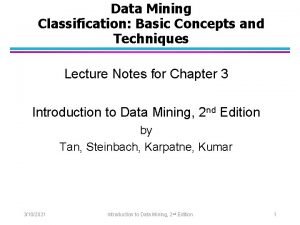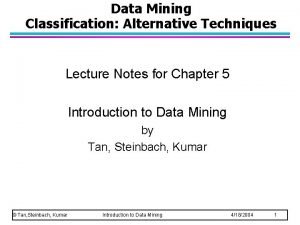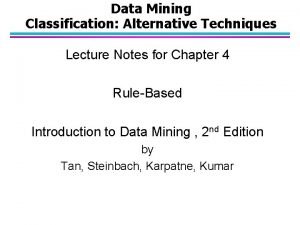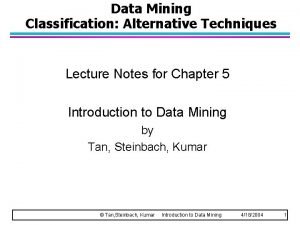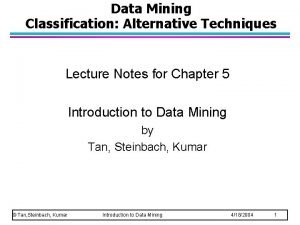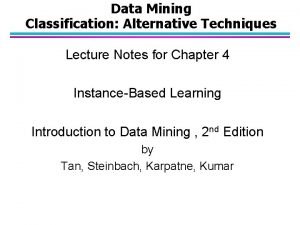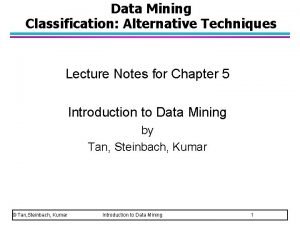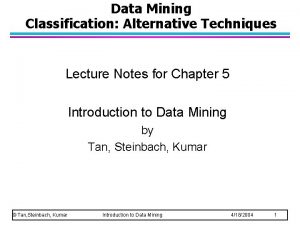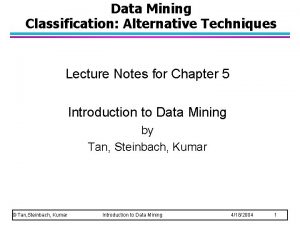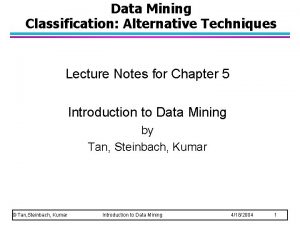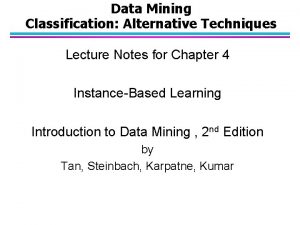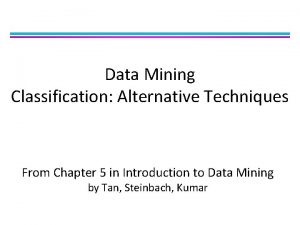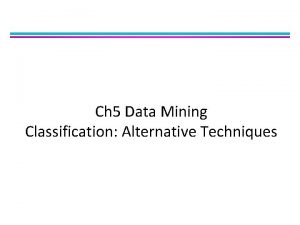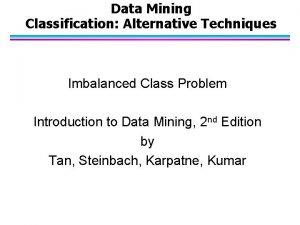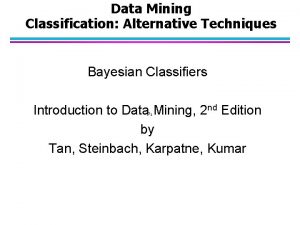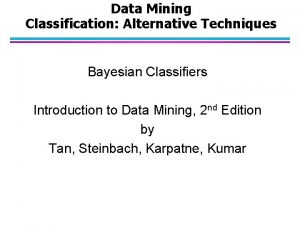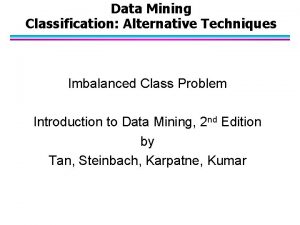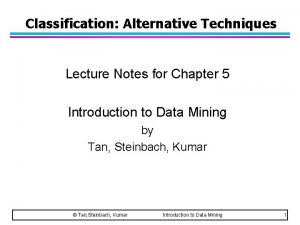Data Mining Classification Alternative Techniques Lecture Notes for















































- Slides: 47

Data Mining Classification: Alternative Techniques Lecture Notes for Chapter 5 Introduction to Data Mining by Tan, Steinbach, Kumar © Tan, Steinbach, Kumar Introduction to Data Mining 4/18/2004 1

Alternative Techniques Rule-Based Classifier – Classify records by using a collection of “if…then…” rules l Instance Based Classifiers l © Tan, Steinbach, Kumar Introduction to Data Mining 4/18/2004 2

Rule-based Classifier (Example) R 1: (Give Birth = no) (Can Fly = yes) Birds R 2: (Give Birth = no) (Live in Water = yes) Fishes R 3: (Give Birth = yes) (Blood Type = warm) Mammals R 4: (Give Birth = no) (Can Fly = no) Reptiles R 5: (Live in Water = sometimes) Amphibians © Tan, Steinbach, Kumar Introduction to Data Mining 4/18/2004 3

Application of Rule-Based Classifier l A rule r covers an instance x if the attributes of the instance satisfy the condition of the rule R 1: (Give Birth = no) (Can Fly = yes) Birds R 2: (Give Birth = no) (Live in Water = yes) Fishes R 3: (Give Birth = yes) (Blood Type = warm) Mammals R 4: (Give Birth = no) (Can Fly = no) Reptiles R 5: (Live in Water = sometimes) Amphibians The rule R 1 covers a hawk => Bird The rule R 3 covers the grizzly bear => Mammal © Tan, Steinbach, Kumar Introduction to Data Mining 4/18/2004 4

How does Rule-based Classifier Work? R 1: (Give Birth = no) (Can Fly = yes) Birds R 2: (Give Birth = no) (Live in Water = yes) Fishes R 3: (Give Birth = yes) (Blood Type = warm) Mammals R 4: (Give Birth = no) (Can Fly = no) Reptiles R 5: (Live in Water = sometimes) Amphibians A lemur triggers rule R 3, so it is classified as a mammal A turtle triggers both R 4 and R 5 A dogfish shark triggers none of the rules © Tan, Steinbach, Kumar Introduction to Data Mining 4/18/2004 5

From Decision Trees To Rules are mutually exclusive and exhaustive Rule set contains as much information as the tree © Tan, Steinbach, Kumar Introduction to Data Mining 4/18/2004 6

Rules Can Be Simplified Initial Rule: (Refund=No) (Status=Married) No Simplified Rule: (Status=Married) No © Tan, Steinbach, Kumar Introduction to Data Mining 4/18/2004 7

Instance-Based Classifiers • Store the training records • Use training records to predict the class label of unseen cases © Tan, Steinbach, Kumar Introduction to Data Mining 4/18/2004 8

Instance Based Classifiers l Examples: – Rote-learner Memorizes entire training data and performs classification only if attributes of record match one of the training examples exactly u – Nearest neighbor Uses k “closest” points (nearest neighbors) for performing classification u © Tan, Steinbach, Kumar Introduction to Data Mining 4/18/2004 9

Nearest Neighbor Classifiers l Basic idea: – If it walks like a duck, quacks like a duck, then it’s probably a duck Compute Distance Training Records © Tan, Steinbach, Kumar Test Record Choose k of the “nearest” records Introduction to Data Mining 4/18/2004 10

Nearest-Neighbor Classifiers l Requires three things – The set of stored records – Distance Metric to compute distance between records – The value of k, the number of nearest neighbors to retrieve l To classify an unknown record: – Compute distance to other training records – Identify k nearest neighbors – Use class labels of nearest neighbors to determine the class label of unknown record (e. g. , by taking majority vote) © Tan, Steinbach, Kumar Introduction to Data Mining 4/18/2004 11

Definition of Nearest Neighbor K-nearest neighbors of a record x are data points that have the k smallest distance to x © Tan, Steinbach, Kumar Introduction to Data Mining 4/18/2004 12

Nearest Neighbor Classification l Compute distance between two points: – Euclidean distance l Determine the class from nearest neighbor list – take the majority vote of class labels among the k-nearest neighbors – Weigh the vote according to distance u weight factor, w = 1/d 2 © Tan, Steinbach, Kumar Introduction to Data Mining 4/18/2004 13

Nearest Neighbor Classification… l Choosing the value of k: – If k is too small, sensitive to noise points – If k is too large, neighborhood may include points from other classes © Tan, Steinbach, Kumar Introduction to Data Mining 4/18/2004 14

Nearest Neighbor Classification… l Scaling issues – Attributes may have to be scaled to prevent distance measures from being dominated by one of the attributes – Example: height of a person may vary from 1. 5 m to 1. 8 m u weight of a person may vary from 90 lb to 300 lb u income of a person may vary from $10 K to $1 M u – Solution: Normalize the vectors to unit length © Tan, Steinbach, Kumar Introduction to Data Mining 4/18/2004 15

Nearest neighbor Classification… l k-NN classifiers are lazy learners – It does not build models explicitly – Unlike eager learners such as decision tree induction and rule-based systems – Classifying unknown records are relatively expensive © Tan, Steinbach, Kumar Introduction to Data Mining 4/18/2004 16

Artificial Neural Networks (ANN) © Tan, Steinbach, Kumar Introduction to Data Mining 4/18/2004 17

Artificial Neural Networks (ANN) l What is ANN? © Tan, Steinbach, Kumar Introduction to Data Mining 4/18/2004 18

Artificial Neural Networks (ANN) Dendrites Axon Weight Cell Body Nucleus Synapse © Tan, Steinbach, Kumar x 1 w 12 x 2 w w 3 x 3 Input (X) Introduction to Data Mining Neuron S b y Output (Y) 4/18/2004 19

Artificial Neural Networks (ANN) Output Y is 1 if at least two of the three inputs are equal to 1. © Tan, Steinbach, Kumar Introduction to Data Mining 4/18/2004 20

Artificial Neural Networks (ANN) © Tan, Steinbach, Kumar Introduction to Data Mining 4/18/2004 21

Artificial Neural Networks (ANN) l Model is an assembly of inter-connected nodes and weighted links l Output node sums up each of its input value according to the weights of its links l Perceptron Model or Compare output node against some threshold t © Tan, Steinbach, Kumar Introduction to Data Mining 4/18/2004 22

General Structure of ANN Training ANN means learning the weights of the neurons © Tan, Steinbach, Kumar Introduction to Data Mining 4/18/2004 23

Algorithm for learning ANN l Initialize the weights (w 0, w 1, …, wk) l Adjust the weights in such a way that the output of ANN is consistent with class labels of training examples – Objective function: – Find the weights wi’s that minimize the above objective function e. g. , backpropagation algorithm (see lecture notes) u © Tan, Steinbach, Kumar Introduction to Data Mining 4/18/2004 24

Support Vector Machines l Find a linear hyperplane (decision boundary) that will separate the data © Tan, Steinbach, Kumar Introduction to Data Mining 4/18/2004 25

Support Vector Machines l One Possible Solution © Tan, Steinbach, Kumar Introduction to Data Mining 4/18/2004 26

Support Vector Machines l Another possible solution © Tan, Steinbach, Kumar Introduction to Data Mining 4/18/2004 27

Support Vector Machines l Other possible solutions © Tan, Steinbach, Kumar Introduction to Data Mining 4/18/2004 28

Support Vector Machines l l Which one is better? B 1 or B 2? How do you define better? © Tan, Steinbach, Kumar Introduction to Data Mining 4/18/2004 29

Support Vector Machines l Find hyperplane maximizes the margin => B 1 is better than B 2 © Tan, Steinbach, Kumar Introduction to Data Mining 4/18/2004 30

Support Vector Machines © Tan, Steinbach, Kumar Introduction to Data Mining 4/18/2004 31

Support Vector Machines l We want to maximize: – Which is equivalent to minimizing: – But subjected to the following constraints: u This is a constrained optimization problem – Numerical approaches to solve it (e. g. , quadratic programming) © Tan, Steinbach, Kumar Introduction to Data Mining 4/18/2004 32

Support Vector Machines l What if the problem is not linearly separable? © Tan, Steinbach, Kumar Introduction to Data Mining 4/18/2004 33

Support Vector Machines l What if the problem is not linearly separable? – Introduce slack variables u Need to minimize: u Subject to: © Tan, Steinbach, Kumar Introduction to Data Mining 4/18/2004 34

Nonlinear Support Vector Machines l What if decision boundary is not linear? © Tan, Steinbach, Kumar Introduction to Data Mining 4/18/2004 35

Nonlinear Support Vector Machines l Transform data into higher dimensional space © Tan, Steinbach, Kumar Introduction to Data Mining 4/18/2004 36

Ensemble Methods l Construct a set of classifiers from the training data l Predict class label of previously unseen records by aggregating predictions made by multiple classifiers © Tan, Steinbach, Kumar Introduction to Data Mining 4/18/2004 37

General Idea © Tan, Steinbach, Kumar Introduction to Data Mining 4/18/2004 38

Why does it work? l Suppose there are 25 base classifiers – Each classifier has error rate, = 0. 35 – Assume classifiers are independent – Probability that the ensemble classifier makes a wrong prediction: © Tan, Steinbach, Kumar Introduction to Data Mining 4/18/2004 39

Examples of Ensemble Methods l How to generate an ensemble of classifiers? – Bagging – Boosting © Tan, Steinbach, Kumar Introduction to Data Mining 4/18/2004 40

Bagging l Sampling with replacement l Build classifier on each bootstrap sample l Each sample has probability (1 – 1/n)n of being selected © Tan, Steinbach, Kumar Introduction to Data Mining 4/18/2004 41

Boosting l An iterative procedure to adaptively change distribution of training data by focusing more on previously misclassified records – Initially, all N records are assigned equal weights – Unlike bagging, weights may change at the end of boosting round © Tan, Steinbach, Kumar Introduction to Data Mining 4/18/2004 42

Boosting Records that are wrongly classified will have their weights increased l Records that are classified correctly will have their weights decreased l • Example 4 is hard to classify • Its weight is increased, therefore it is more likely to be chosen again in subsequent rounds © Tan, Steinbach, Kumar Introduction to Data Mining 4/18/2004 43

Example: Ada. Boost l Base classifiers: C 1, C 2, …, CT l Error rate: l Importance of a classifier: © Tan, Steinbach, Kumar Introduction to Data Mining 4/18/2004 44

Example: Ada. Boost l Weight update: If any intermediate rounds produce error rate higher than 50%, the weights are reverted back to 1/n and the resampling procedure is repeated l Classification: l © Tan, Steinbach, Kumar Introduction to Data Mining 4/18/2004 45

Illustrating Ada. Boost Initial weights for each data point © Tan, Steinbach, Kumar Introduction to Data Mining Data points for training 4/18/2004 46

Illustrating Ada. Boost © Tan, Steinbach, Kumar Introduction to Data Mining 4/18/2004 47
 Classification alternative techniques in data mining
Classification alternative techniques in data mining Bayesian classification in data mining lecture notes
Bayesian classification in data mining lecture notes Data mining lecture notes
Data mining lecture notes Data mining lecture notes
Data mining lecture notes Data mining lecture notes
Data mining lecture notes Eck
Eck 01:640:244 lecture notes - lecture 15: plat, idah, farad
01:640:244 lecture notes - lecture 15: plat, idah, farad Mining multimedia databases
Mining multimedia databases Data mining concepts and techniques
Data mining concepts and techniques Function of data mining
Function of data mining Data mining concepts and techniques slides
Data mining concepts and techniques slides Data mining concepts and techniques slides
Data mining concepts and techniques slides Binning techniques in data mining
Binning techniques in data mining Association data mining techniques
Association data mining techniques Exploratory data analysis lecture notes
Exploratory data analysis lecture notes Classification and clustering in data mining
Classification and clustering in data mining Basic concepts of classification in data mining
Basic concepts of classification in data mining Strip mining vs open pit mining
Strip mining vs open pit mining Mineral resources and mining chapter 13
Mineral resources and mining chapter 13 Difference between strip mining and open pit mining
Difference between strip mining and open pit mining Web text mining
Web text mining Data reduction in data mining
Data reduction in data mining Data mining in data warehouse
Data mining in data warehouse What is missing data in data mining
What is missing data in data mining Data reduction in data mining
Data reduction in data mining Data reduction in data mining
Data reduction in data mining Data reduction in data mining
Data reduction in data mining Data cube technology in data mining
Data cube technology in data mining Data reduction in data mining
Data reduction in data mining Perbedaan data warehouse dan data mining
Perbedaan data warehouse dan data mining Perbedaan data warehouse dan data mining
Perbedaan data warehouse dan data mining Crm data warehouse models
Crm data warehouse models Mining complex types of data
Mining complex types of data Olap data warehouse
Olap data warehouse Noisy data in data mining
Noisy data in data mining 3-tier data warehouse architecture
3-tier data warehouse architecture Data preparation for data mining
Data preparation for data mining Data compression in data mining
Data compression in data mining Introduction to data mining and data warehousing
Introduction to data mining and data warehousing Data warehouse dan data mining
Data warehouse dan data mining Cs 412 introduction to data mining
Cs 412 introduction to data mining Project procurement management lecture notes
Project procurement management lecture notes Theology proper lecture notes
Theology proper lecture notes Public sector definition
Public sector definition Software project management handwritten notes
Software project management handwritten notes Electricity and magnetism lecture notes
Electricity and magnetism lecture notes Classical mechanics
Classical mechanics Physical science lecture notes
Physical science lecture notes
